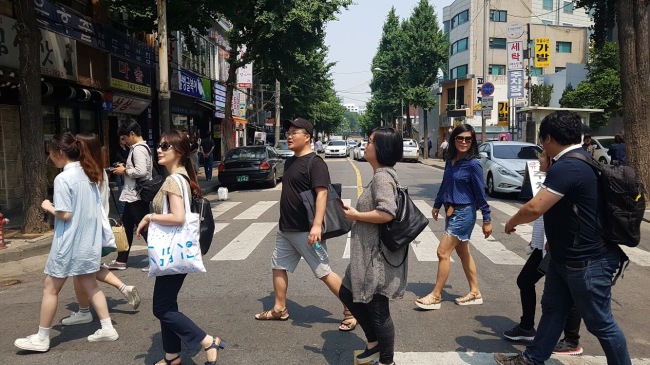Kim Hyun-ji, an education program planner at the National Museum of Modern and Contemporary Art, has combed the alleys of Seoul to find the hidden gems of the city for the past two months, leading a group of citizens.
She was supposed to provide an expert’s view, but the excursions were also an opportunity for her to rediscover the beautiful and vibrant city that is Seoul, constantly changing and evolving.
 |
Participants of “Arts on Seoul’s street found by citizens” pose for a photo during their field work in Seoul. (The Seoul Metropolitan Government) |
Aging homes transform into cafes and restaurants. Placards notifying renovation work clutter streets, with newly-opening shops, all without harming the original ambience of the area.
“When looking at the Seoul City’s urban restoration projects, it is interesting how historical values or decadeslong originality of neighborhoods are preserved even after the transformation,” Kim told The Korea Herald.
Kim is one of 11 curators participating in the Seoul Metropolitan Government’s public art project called “Arts on Seoul’s street found by citizens.” A total of 105 Seoul citizens are part of the two-month long project that kicked off in May to find and promote the hidden artistic gems of Seoul.
Throughout the project, the participants are asked to make suggestions on ways to promote Seoul’s art scenes, along with field works and lectures on public art theories.
“One other thing I discovered about Seoul’s town redevelopment and gentrification is that public art can play a positive role in the city’s restoration,” said the 40-year-old industry insider.
Aiming to find Seoul’s unknown charms, Kim led a group of 10 participants and held 10 rounds of field work in areas such as Ikseon-dong in Jongno-gu.
Kim said Seoul is full of artistic appeal found in unexpected areas.
“The recent gentrification of Ahyeon-dong was peculiar. ‘Haenghwatang,’ a public bath house which opened its door in 1950s, is a good example,” Kim said.
It used to be frequented by nearby residents until that part of the region underwent rapid development, along with the construction of apartments in 2011.
With a boom of clean and large sauna houses and young people averting public bathing altogether, Haenghwatang struggled to make ends meet for many years until it was transformed into one of the most unique cultural spaces in Seoul.
“Many can ask what public art has to do with urban restoration. If one defines public art as something that vitalizes the community with artistic appeal, there is no boundary because art can change the purpose of buildings and space,” said Kim.
The SMG’s two-month project “Arts on Seoul’s street found by citizens” will come to an end Saturday. To wrap it up, participants will gather and give their final presentations on their discoveries at Seoul City Hall, according to the city government’s design policy division.
The final presentation is open to all visitors. Those interested can join the event at Seoul City Hall’s multipurpose hall on Saturday at 4 p.m.
By Kim Da-sol (
ddd@heraldcorp.com)





![[Exclusive] Hyundai Mobis eyes closer ties with BYD](http://res.heraldm.com/phpwas/restmb_idxmake.php?idx=644&simg=/content/image/2024/11/25/20241125050044_0.jpg)
![[Herald Review] 'Gangnam B-Side' combines social realism with masterful suspense, performance](http://res.heraldm.com/phpwas/restmb_idxmake.php?idx=644&simg=/content/image/2024/11/25/20241125050072_0.jpg)

